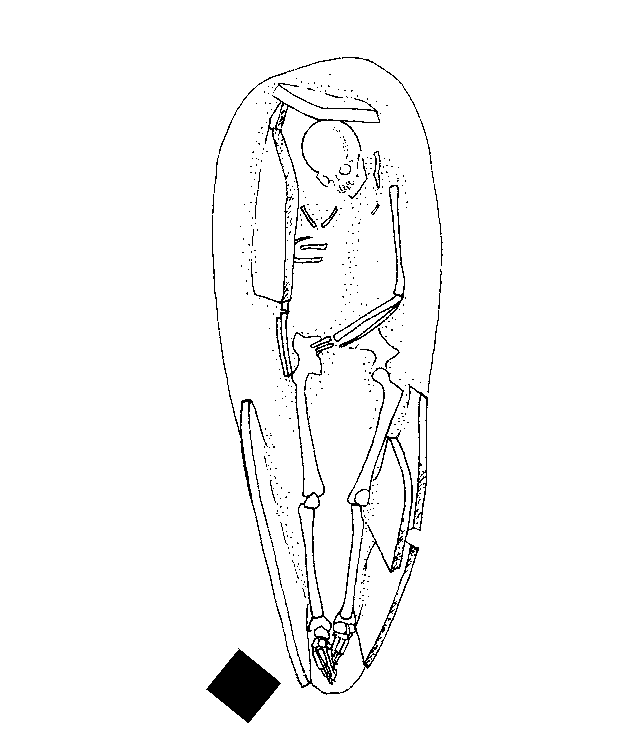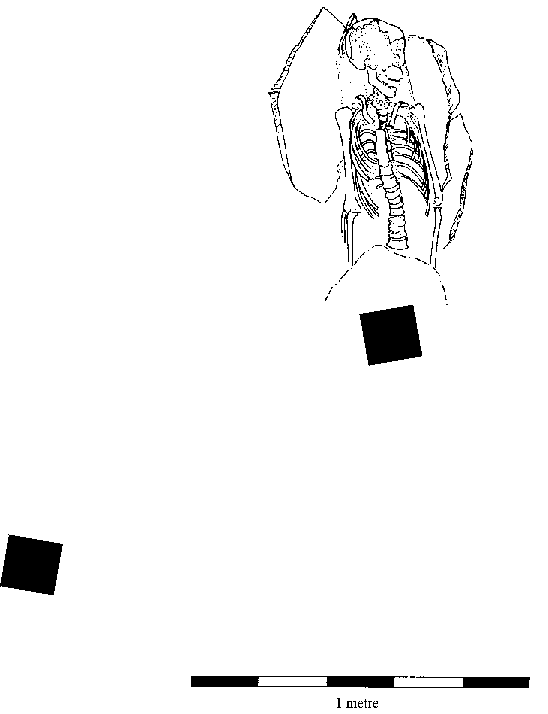 Bulletin
3, 1997
Bulletin
3, 1997
The People of Tarbat
Preliminary assessment of human bone from the excavations in St Colman's Church By Annette Roe, based on research by Don Brothwell.
Recovery of the data
An evaluation area of c4m x 5m (Int17, Bull 2, 15) had proved that the density of burials, inter-cutting in the homogenous dry powdery sand in the first 0.3-0.4m beneath the flagstone floor of the nave, had resulted in a deposit resembling charnel with almost all the bone disarticulated and disturbed. It was therefore decided to excavate this material as a single context over the whole of the nave down to the horizon where cuts could be defined. The skeletal material from this context was recovered by sieving through a 10mm mesh. Beneath this "charnel layer", some 150 burials were stratigraphically defined in the nave of the church.
The skeletal material can thus be divided into two main groups: the mixed assemblage of disturbed or redeposited bone ("charnel") which formed the ultimate horizon within the church; and the sequence of inhumations excavated beneath this.
Comments on the charnel assemblage
The Tarbat charnel amounted to c14,000 assessable bones or fragments. Using the evidence of mandibles and sacra (lower spine), the minimum number of individuals involved would be a little over 100. This is unlikely to represent all the young children, whose fragile bones may have become unidentifiable. Taking this into account, a number nearer 200 would be more likely. The spine, sternum (breastbone), hands, feet and patella (knee cap) were all less well represented than they should have been given a minimum number of 100 individuals. The recovery was standardised at Level D, with all spoil being sieved through a 10mm mesh; the uneven representation therefore implies the loss of bone through preferential decay or fragmentation.
Estimates of stature from this assemblage give an average height of 1.677m (approx. 5' 7") for males, noticeably shorter than Scotsmen today. Evidence for disease has been recorded in considerable detail, especially relating to the joints, jaws and teeth. There is evidence for cancer, but none for tuberculosis or leprosy. A common congenital condition - causing fusion of the skull with the upper pine is present in two individuals. One individual displays severe blade cuts about the head, which killed him; two others show single blade cuts, probably from a sword, which proved fatal.
Comments on the stratified burials (Fig 7)
Although as yet very little analysis has been undertaken on their phasing, the stratified burials can be divided into three broad groups: cist burials (phase 0); the head-setting burials (phase I); and the burials with coffins (phases 2 - 4). There was an apparent lack of juvenile burials in the earlier groups. Among the later burials preservation was good and sometimes extraordinary, as in the case of wood from coffins, a pair of leather shoes, flesh from a foot, organic matter from brains and hair from the head and pubic region. A fragment of textile has been given preliminary examination by Penelope Walton Rogers, who finds that it is typical medium-weight clothing fabric of the 14 - 16th century, probably comes from leggings or "foot-hose" and was associated with light-brown hair from a man's legs (Walton Rogers archive report).

Head-setting burials (F120/17, F97/20)

Coffin burial (F75/20)

Figure 7: Three types of burial
Dating: No radiocarbon dates have been obtained as yet, and the date range is provisionally assumed to be from the 9th century or earlier (as suggested by the stratigraphically earliest burials, of long cist type), to the period of the reformation in the 16th to 17th century, after which a flag stone floor was laid and burial in the nave discouraged or disallowed.
Research Programme
A researcher is to be appointed shortly who will examine the articulated skeletons and complete the synthesis of the charnel. A report on all the material is scheduled to appear in the final account of the excavations in St Colman's Church, which is currently being prepared for publication by Annette Roe.
The charnel bones, together with disarticulated bones previously cleared from the crypts, have already been re-interred in the nave of the church, following a service of reburial. As soon as their analysis is complete, the bones of the articulated skeletons will be buried in the "crypt" of the north aisle, a burial vault constructed shortly after the Reformation for the members of the Mackenzie family.
Excavation of the service trench (Int 22)
A narrow (0.8m) wide trench was excavated to carry services from the road near the present churchyard entrance along the path to the south door of the church. This was excavated archaeologically in order to document, if possible, any evidence for development and growth of the churchyard. The south facing section was drawn along the length of the trench and features and structures were also recorded in plan.
The trench passed through a shallow earthwork which ran in a north-south direction to the east of the present churchyard entrance. This earthwork was a candidate for an early boundary to the church enclosure. On removal of the turf, the earthwork proved to contain fairly insubstantial remains of a mortar-bonded wall with a very shallow foundation. This would appear to have been the limit of the churchyard before its enlargement recorded in 1868, a review of the dated tombstones west of this line endorsing this identification. (The churchyard was recorded as being extended again in 1893, this time into land lying to the south of the church).
Beneath this wall had been captured a small but very useful block of stratification which could be identified as representing the general sequence on the hill of St Colman's Church. Elsewhere this sequence of strata had been destroyed or scrambled, to the east by later burials and to the west by ploughing. Although the trench was not cut deep enough to test securely the natural subsoil, many layers of windblown sand, possible buried soils and even horizons of burnt silt sand were recognised and recorded and were reminiscent of the stratification encountered in the Glebe Field excavations (Sector 2) further west. Unfortunately no directly datable material was recovered from any of these earlier layers.
This boundary seems to have been preceded by an earlier boundary wall further east. Other foundations were also encountered nearer to the church, but apparently not forming part of its known plan. Now that their existence is known, attempts will be made to map these wall-lines using calibrated geophysical surveys.
New finds of sculpture to April 1998 (Fig 3)
The discovery and extraction of sculptural fragments TR 20-31 was reported in Bulletin No 2 for 1996, 19-25. Three new fragments have since come to light during the repair and reconstruction programme for the church.
TR 32 was located within the blocking beneath the relieving arch of the west end (phase 7). It is a fragment measuring 146 x 70 x 52mm, bearing decoration on both of its two surviving faces. On one face there is part of a panel of spirals similar in style to those seen on fragment TR18; on the other face is a corner of incised key pattern.

Figure 8: New piece of sculpture discovered during restoration work, TR33. (Drawn by Trevor Pearson)
TR 33 was located in the foundation of the south wall of the phase 2 church. It is a grave-marker measuring 524 x 212 x 56mm, carrying a cross in relief (Fig 8) which like other Tarbat sculpture finds some parallels to carved stones found at Iona (Fig 9).

Figure 9: Parallels between Tarbat and Iona forms of sculpture.
TR34 was located in the rubble foundations of the external stair to the north aisle (phase 8). It is a fragment from another grave-marker measuring 350 x 350 x 75mm and bearing a hollow-armed cross in low relief. The reverse shows signs of re-use.
The most recent catalogue of sculptural fragments from Tarbat is assembled in graphical form in Appendix 2 to this Bulletin. The extant pieces of the pre-1991 corpus (TR 1-16) are being retained by the National Museums of Scotland and will form part of their display. Some or all of these will eventually by replicated for the display centre at Tarbat. The pieces found since 1992 (TR 17-34) are currently being conserved through the good offices of the National Museums and will be returned for inclusion in the display presently being designed and built as the Tarbat Display Centre.
The carved stone ball from Sector 4 (Fig 10)
During the reburial service for the charnel bones inside the nave of the church, a carved stone ball was spotted by Caroline Shepherd-Baron (Chair of Tarbat Historic Trust). The ball, which had become exposed subsequent to the completion of excavations in the nave, had originally been incorporated in the foundations for the early church (phase 2), which were otherwise composed of waterworn boulders, probably from the sea shore. The ball is of the 6-knob type, with a "nose-shaped" triangle in an interspace (type 4c). Marshall's survey (1976-7) recorded 14 of this type, out of some 390 balls in all, including two from the north. The carved stone balls are dated to the early Bronze Age (c 2000 BC) and have a distribution which pre-echoes that of the Pictish symbol stones. Numerous explanations have been offered for them, including uses as mace-heads, weights, in games, as symbols of office, and in healing and ritual (Marshall 1976-7, 62-63).
Figure 10: The carved stone ball from sector 4. (Drawn by Trevor Pearson)
NEXT: Comments
BACK: Tarbat Old Church
Last updated 10 October, 2003.
Contact the Tarbat Discovery Programme



